Community Embraces New Word Game at Mid-Year Play Day This past Sunday, families at Takoma Park’s Seventh Annual Mid-Year Play Day had the opportunity to experience OtherWordly for the first time. Our educational language game drew curious children and parents to our table throughout the afternoon. Words in Space Several children gathered around our iPads […]
Read more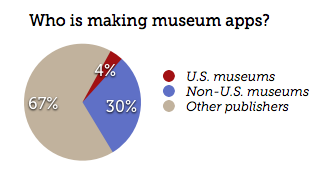 The vast majority of museums are totally ignoring mobile apps.
The vast majority of museums are totally ignoring mobile apps.
At present, ~350 iPhone apps have been actually created by museums. Of those, only one out of ten was created by a U.S. museum (the rest are non-U.S.). The other 760 iPhone apps matching “museum” in their title or description were created by travel and culture publishers, most of which are poor quality.
These pathetic numbers ignore smartphone reality. In the U.S. alone, half of all mobile phone customers now have smartphones, and there will soon be 1 million new smartphone (smartphones run apps) subscribers a week. This will be virtually all U.S. households in 5-7 years. Currently, Android and iOS are the two main app platforms. Numbers in Europe are similar.
Despite mobile’s potential to connect to visitor’s pockets (and pocketbooks), of the ~17,500 museums in the U.S., fewer than 2% currently have a mobile app.
Two recent surveys reveal some of the thinking behind this. These surveys asked questions to a few hundred internet-savvy staff. This was a self-selected pool who saw the surveys in blog posts, Twitter postings, and emails. Even among this internet-savvy community, only 29-40% currently have apps.
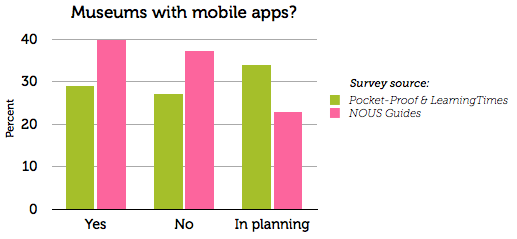
These surveys found that history museums are less inclined towards apps than arts and science museums, and European museums are ahead of the U.S.
Since the real number of museums with apps is closer to 1.7%, that means that 95% of museums are not even part of the discussion (or are ignoring surveys about apps).
Most museums are small, and it’s the small museums that don’t have apps. From the Pocket-Proof survey, the red bars are museums with no apps and no plans to make one. Annual visitation is the left axis:
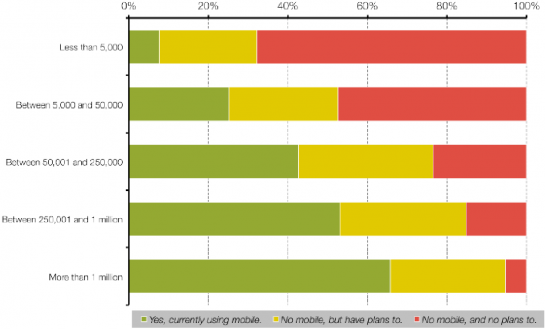
Among the survey respondents who don’t have apps, it was mostly a lack of experience that has led to ignoring apps. Other factors were that it was “not a priority,” and high cost:
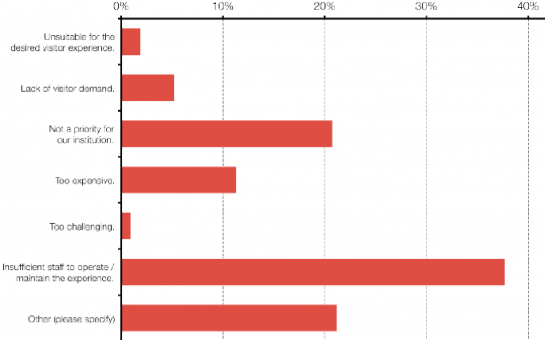
This means there is still a big void: There’s a lack of support in the field for sharing resources and information about making apps, and there are insufficient tools on the low-end for making nice, useful, inexpensive apps that will get these museums onto mobile devices.
Another big problem is that mobile apps and social media are considered “marketing” expenses, as opposed to tools to educate and inform the public. Unless curators and educators are involved, apps will be further hampered because they will be vacuous and uninteresting. NOUS’ survey asked what departments in museums were in charge of mobile and social media:
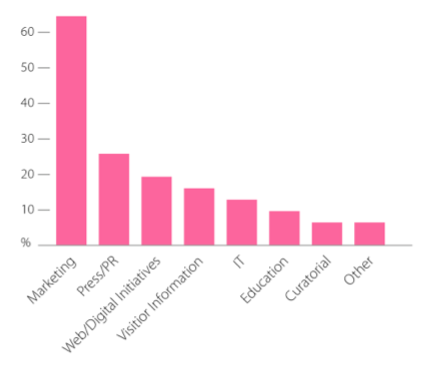
Will museums get a clue, and realize that the museum experience should not stop at the edge of their property? We’ll see.
Notes:
- The third of museums apps actually created by museums was calculated by randomly sampling 2.5% of the 1060 iPhone apps matching “museum,” was returned as search results by iTunes. Of the 9/27 which were real museum apps, only 1 was a U.S. museum. Analysis by IDEA on 16-April-2012.
- The ‘2012 Museums and Mobile Survey‘ was conducted by Pocket-Proof and Learning Times, and surveyed 554 people currently working in museums, 78% of which were in the U.S. Their respondents where 43% from historical organizations (museums, monuments, local heritage), 20% from art museums, and the rest from other types. Data collected Nov 2011 – Jan 2012.
- The ‘Mobile Communication’ survey was conducted by NOUSGuide, and surveyed 122 institutions, reflecting mostly European respondents (the countries were Austria, Germany, Denmark, Netherlands, New Zealand, Australia and the US). Data collected Dec 2011 – Feb 2012.


17 Apr 2012, 11:55 am
Any responsible look at what museums are doing for mobile should include mobile-optimized or responsive design websites, not just apps. Mobile websites are often a more cost-effective and sustainable solution for organizations on a budget as well as those with a commitment to cross-platform compatibility.
17 Apr 2012, 1:18 pm
I agree about mobile-optimized and/or responsive designs. Though there's also value to having an "app" so there's an icon on the desktop, and it's easier to find. The app can be very simple, effectively a wrapper for a mobile site, though working offline, and with sharing capabilities. It should be possible for such apps to be cost in the $500-$2000 range.
18 Apr 2012, 9:00 am
"It should be possible for such apps to be cost in the $500-$2000 range."
It should be. But the reality I've discovered is that even a simple app of any quality (developed in a timely manner) is going to cost 10x that amount as a start.
11 May 2012, 10:34 am
There are several smaller companies that are starting to offer quality apps as a service that are affordable and can be released as soon as the content is ready (No bugs). They are specifically designed for smaller museums in mind and include audio tour components, maps, embedding video and links and other useful features. check out http://www.tourappbuilder.com for ours.
27 Jul 2012, 5:38 am
I totally agree, it should have been done already a couple of years ago. Still, thinking about the costs we can't be too surprised. However, I've seen some of those apps designed for smaller museums and there's more and more of them. So let's hope it's all moving in the right direction.
23 Sep 2012, 10:27 am
yes It should be
05 Jan 2013, 2:35 am
Any responsible look at what museums are doing for mobile should include mobile
18 Jul 2013, 3:54 am
I just had a conversation with a vendor about this. When I told him I was from the Children's Discovery Museum he said, "Oh I think [my family has] a membership, but I don't go very often. When are you open until?" When I replied, "5" he said nodded in a defeated sort of way. I bet a lot of working parents would appreciate evening hours at our museum.